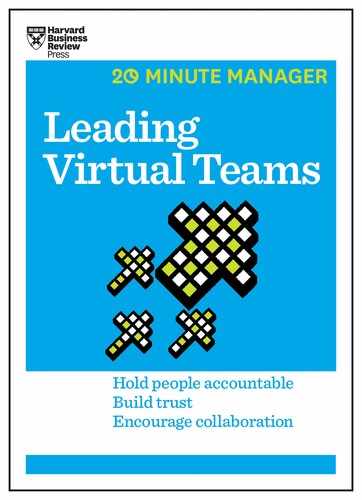Learn More
Quick hits
Dixon, Nancy. “Combining Virtual and Face-to-Face Work.” HBR.org, July 1, 2015. https://hbr.org/2015/07/combining-virtual-and-face-to-face-work.
Even if you mostly work with your team remotely, chances are that you can convene in person—at important milestones, for example, or to conduct a field trip. Dixon, whose research helped pioneer the field of knowledge management, shows you how to get the most out of each type of interaction by “oscillating” strategically between virtual and in-person meetings.
Ferrazzi, Keith. “How to Build Trust on Your Virtual Team.” HBR.org Video, July 14, 2015. https://hbr.org/video/2363593491001/how-to-build-trust-on-your-virtual-team.
Virtual collaboration disrupts the team-building patterns you’re used to seeing in a traditional office: You can’t organize a team lunch, for example, or seat two key collaborators next to each other at a meeting and watch them hit it off. Ferrazzi, a strategic consultant who focuses on professional relationship development, zeroes in on this challenge and outlines four research-based tips for fostering trust between people in faraway places.
Samuel, Alexandra. “Things to Buy, Download, or Do When Working Remotely.” HBR.org, February 4, 2015. https://hbr.org/2015/02/things-to-buy-download-or-do-when-working-remotely.
If you or your team members are working outside the office—at home, at an alternate worksite, or on the road—you’ll want social media expert Alexandra Samuel’s practical tech tips for staying connected and focused away from your base. Remember all the little things that can make or break your day on the go, from putting that extra charger in your car to setting up an emergency communication channel for SOS messages from your team members.
Books
Harvard Business School Publishing. Giving Effective Feedback (20-Minute Manager Series). Boston: Harvard Business Review Press, 2014.
Talking about performance issues is one of the hardest parts of any team leader’s job, and the social distance that technology introduces into these conversations doesn’t help. This book walks you through the basics of giving good feedback no matter what the environment is. You’ll learn how to pick your moment, engage your employee in a two-way dialogue, respond to negative reactions, and follow up on next steps.
Samuel, Alexandra. Work Smarter, Rule Your Email. Boston: Harvard Business Review Press, 2014.
You and your team probably spend more time each day using e-mail than any other tool. Samuel details how to get the most out of this experience. She shows how you can reengineer your settings to see important e-mails first and to make attacking the backlog of unread and unanswered mail a manageable task. Once your team members have cleaned up their inboxes, they can stay on top of incoming messages by developing habits for incorporating e-mail–related tasks into the rest of their workdays.
Saunders, Elizabeth Grace. How to Invest Your Time Like Money. Boston: Harvard Business Review Press, 2015.
Managing the communications apparatus of a virtual team can become a bottomless time sink. If you or one of your team members struggles with this, Saunders can help. Learn to impose discipline on communication and other work activities, so that you consistently put your greatest effort on where it can do the most good. Use the proven techniques and principles of personal finance to figure out how you’re wasting time now, what a more productive schedule would look like, and how to improve your time management.
Articles
Ferrazzi, Keith. “Getting Virtual Teams Right.” Harvard Business Review, December 2014 (product #R1412J).
This comprehensive article combines research-based insight (Ferrazzi surveyed over 1,700 knowledge workers for this piece) with a deep understanding of the human relationships that underlie all teamwork. Ferrazzi highlights communication and transparency as key themes for the virtual leader, and you’ll learn how to maximize these quantities at every point in your team’s life cycle, from staging a kickoff to welcoming a new member onboard.
Johns, Tammy and Linda Gratton. “The Third Wave of Virtual Work.” Harvard Business Review, January 2013 (product #R1301D).
It’s a good idea to pull back for a broader view of the economic and organizational trends that created the virtual team you’re leading today. Johns and Gratton look at how virtual work has evolved, and they outline how companies should arrange their space, talent, and workflows to make the most of these changes. While this article takes a higher-level perspective on virtual work, you’ll gain concrete insight into the dynamics governing your colleagues’ day-to-day experiences.
Majchrzak, Ann, Arvind Malhotra, Jeffrey Stamps, and Jessica Lipnack. “Can Absence Make a Team Grow Stronger?” Harvard Business Review, May 2004 (product #R0405J).
Most advice on leading virtual teams focuses on how you can replicate the dynamics that make face-to-face collaborations so successful. But sometimes difference is good. Majchrzak and her coauthors show that by pushing tools that allow your people to hold ongoing, threaded discussions, you can bypass inefficient meetings and foster creativity and initiative in trusted colleagues. Your team becomes even more productive apart than it could ever be if all the members were in the same place.
